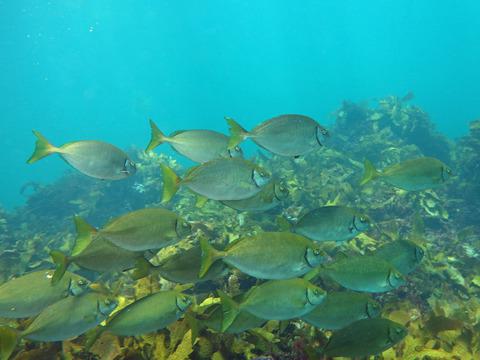当前位置:
X-MOL 学术
›
Funct. Ecol.
›
论文详情
Our official English website, www.x-mol.net, welcomes your
feedback! (Note: you will need to create a separate account there.)
Range‐extending tropical herbivores increase diversity, intensity and extent of herbivory functions in temperate marine ecosystems
Functional Ecology ( IF 4.6 ) Pub Date : 2020-08-09 , DOI: 10.1111/1365-2435.13662 Salvador Zarco‐Perello 1 , Gemma Carroll 2, 3 , Mat Vanderklift 4 , Thomas Holmes 5 , Tim J. Langlois 1 , Thomas Wernberg 1
中文翻译:

范围扩大的热带食草动物增加了温带海洋生态系统中食草功能的多样性,强度和程度
更新日期:2020-08-09
Functional Ecology ( IF 4.6 ) Pub Date : 2020-08-09 , DOI: 10.1111/1365-2435.13662 Salvador Zarco‐Perello 1 , Gemma Carroll 2, 3 , Mat Vanderklift 4 , Thomas Holmes 5 , Tim J. Langlois 1 , Thomas Wernberg 1
Affiliation

|
- Climate change is modifying species distributions around the world, forcing some species poleward, where they can alter trophic interactions. Many tropical herbivorous fishes have successfully expanded their ranges into temperate ecosystems, and while it is clear they drive increases in herbivory rates in specific localities, little is known about how they might affect the diversity of herbivory functions across large spatial scales, considering their interaction with assemblages of native herbivores in temperate habitats.
- We assessed the spatial overlap and habitat associations of native temperate and range‐expanding tropical herbivorous fishes in six subregions of south‐western Australia to determine how incursions of tropical species may have affected the diversity, redundancy (index of uniqueness) and the ‘spatial extent’ (addition of functions in new areas) and ‘intensity’ (increasing density of functional groups) of specific herbivory functions in recipient ecosystems.
- Tropical herbivores had high abundances in temperate ecosystems, forming schools from 40 (parrotfish) to 200 (rabbitfish) individuals strongly associated with seagrass meadows and reefs with high cover of turf algae. Overlap with temperate herbivores was highest in the northern subregions, forming unique assemblages, with no apparent species displacements. The addition of tropical species increased functional diversity and uniqueness (the complement of redundancy), introducing novel herbivory functions to many locations. Seagrass browsing increased in spatial extent (27%) and intensity (15×), while seaweed browsing and grazing increased in intensity by up to 2.5× in regions with high abundances of tropical herbivores.
- Our results suggest that the diversity, intensity and spatial extent of different herbivory functions can change as tropical species with different habitat affinities, behaviours and diets shift their distributions poleward. Changes in functional redundancy are likely to be heterogeneous in space and might not increase initially because the diversity of herbivory functions is relatively low in some temperate marine ecosystems. However, there is the potential for greater redundancy as further tropical species arrive, their abundances increase and the spatial and functional overlap of communities rises.
中文翻译:

范围扩大的热带食草动物增加了温带海洋生态系统中食草功能的多样性,强度和程度
- 气候变化正在改变世界各地的物种分布,迫使某些物种处于两极分化状态,它们可以改变营养相互作用。许多热带草食性鱼类已成功地将其范围扩大到温带生态系统,尽管很明显它们推动了特定地区草食性比率的增加,但考虑到它们与大范围空间尺度的相互作用,它们如何影响草食性功能的多样性却鲜为人知。温带栖息地中的天然草食动物的组合。
- 我们评估了澳大利亚西南部六个分区的温带和范围扩大的热带草食鱼类的空间重叠和栖息地关联,以确定热带物种的入侵如何影响多样性,冗余度(独特性指数)和“空间范围”。接收者生态系统中特定草食功能的强度(在新区域中增加功能)和强度(功能组的密度增加)。
- 热带草食动物在温带生态系统中的丰度很高,形成了由40个(鹦嘴鱼)到200个(兔鱼)个体的学校,这些个体与海草草甸和礁石紧密地覆盖着大量草皮藻。温带草食动物的重叠在北部次区域最高,形成独特的组合,没有明显的物种移位。热带物种的增加增加了功能多样性和独特性(冗余的补充),在许多地方引入了新的食草功能。在热带草食动物丰富的地区,海草的浏览在空间范围内(27%)和强度(15倍)增加,而海藻的浏览和放牧强度则提高了2.5倍。
- 我们的结果表明,随着具有不同生境亲和力,行为和饮食的热带物种的极地分布,不同草食功能的多样性,强度和空间范围会发生变化。功能冗余的变化可能在空间上是异质的,最初可能不会增加,因为在某些温带海洋生态系统中,草食功能的多样性相对较低。但是,随着更多热带物种的到来,其丰富度的增加以及群落的空间和功能重叠的增加,可能存在更大的冗余度。











































 京公网安备 11010802027423号
京公网安备 11010802027423号